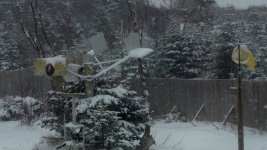tractorgp
Platinum Member
Outstanding!
Thanks! Might be a good time to ask a question TBN'ers about gas springs. I installed 2 gas springs on the turbine, one on each of the tail arms. The spring are rated at about 20 pounds each. By a bit of luck the springs gave me just about the right amount of force to cause the turbine tail to tilt back with moderate wind speeds. The tail tilt brings the power plate up in front of the turbine buckets to control the turbine rpm. By observing the turbine operation over the last few months I learned that the turbine tail will tilt back just when the wind speed reaches 30 km/h (about 18 mph). I also noted that the gas springs gave a smoother action during tilt-back and tilt return - when I was using dead weights the tilting action was more abrupt and unsteady (usually with some bouncing). 30 km/h is too soon to start controlling the turbine rpm but I know that I can "easily" adjust that to a higher speed by reducing the area of the horizontal sections of the tail. So all of that is good.
This is the first time I have used gas springs and from a little bit of research I found that the cylinders contains nitrogen gas under high pressure pushing against the piston to give the spring action. I bought the springs on-line for about $10 each and they were rated for inside use. I actually ordered 4 springs (2 for backup) as I assumed I would have trouble with corrosion or whatever due to my intended application.
So the springs and the turbine worked just fine over the last few winter months up until a few weeks ago. After a real good winter storm, the springs failed. I could tell this as the turbine went into "safe" mode... i.e. the tail tilted back and stayed tilted back most of the time even with zero winds. Occasionally the turbine would tilt forward with different wind directions and speeds but for the most part it stayed tilted back.
I assumed the gas leaked out of the cylinders and reasoned that that is ok in view of the intended application of the springs (inside kitchen doors, etc.). I did a visual check for rust but nothing noticeable.
Then after a few good wind storms the springs came back to life, at least back to some life, as the tail reverted to its "normal" action - meaning that the spring force had returned and everything worked as normal except that the turbine tail was tilting back at somewhat lower wind speeds - maybe 20 km/h rather than the original 30 km/h.
The video that I included above shows the turbine operating in that mode (tilting at about 20 km/h).
So how did the spring force return? That is my question.
And today (two days after the video above was made) the springs seem to have once again lost all or most force as the tail is tilted back with pretty well zero wind.
Any ideas on what might be going on with the gas springs?

